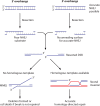53BP1, BRCA1, and the choice between recombination and end joining at DNA double-strand breaks
- PMID: 24469398
- PMCID: PMC3993578
- DOI: 10.1128/MCB.01639-13
53BP1, BRCA1, and the choice between recombination and end joining at DNA double-strand breaks
Abstract
When DNA double-strand breaks occur, the cell cycle stage has a major influence on the choice of the repair pathway employed. Specifically, nonhomologous end joining is the predominant mechanism used in the G1 phase of the cell cycle, while homologous recombination becomes fully activated in S phase. Studies over the past 2 decades have revealed that the aberrant joining of replication-associated breaks leads to catastrophic genome rearrangements, revealing an important role of DNA break repair pathway choice in the preservation of genome integrity. 53BP1, first identified as a DNA damage checkpoint protein, and BRCA1, a well-known breast cancer tumor suppressor, are at the center of this choice. Research on how these proteins function at the DNA break site has advanced rapidly in the recent past. Here, we review what is known regarding how the repair pathway choice is made, including the mechanisms that govern the recruitment of each critical factor, and how the cell transitions from end joining in G1 to homologous recombination in S/G2.
Figures



References
Publication types
MeSH terms
Substances
Grants and funding
LinkOut - more resources
Full Text Sources
Other Literature Sources
Miscellaneous
